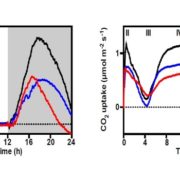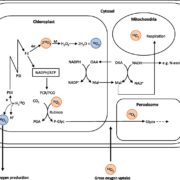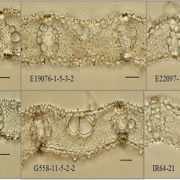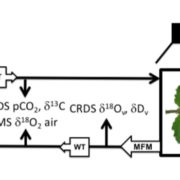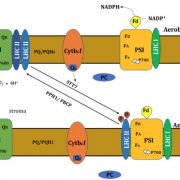CA-nundrum: How a spontaneous mutation in carbonic anhydrase uncouples leaf δ13C, WUE and C4 photosynthesis
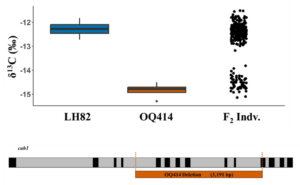 With climate change, drought is expected to happen more frequently, making supplemental irrigation increasingly necessary to sustain crop productivity. One target trait to improve climate resilience is water use efficiency (WUE), defined by the ratio of carbon assimilation to water used by the plant. However, directly measuring WUE is time consuming and low-throughput, highlighting the need for proxy traits that enable large-scale phenotyping. Leaf tissue stable carbon isotope composition (δ13Cleaf) is commonly used as a proxy for WUE because it reflects CO2 availability and carbon metabolism. In this study, Twohey et al. investigated two maize lines, OQ414 and LH82, which showed similar morphological characteristics but very different δ13Cleaf values. A biparental mapping F2 population derived from these two lines showed a simple dominance segregation pattern for δ13Cleaf. Genetic mapping identified a major QTL on chromosome 3, located within 1 LOD of the carbonic anhydrase 1 (cah1) and carbonic anhydrase 2 (cah2) loci. Complementation test confirmed that the phenotype observed was due to a mutation in cah1. Sequencing revealed that OQ414 harbors a deletion in exons 5-10 and part of exon 11 in cah1. Surprisingly, this mutation led to significantly increased carbonic anhydrase (CA) content and photosynthetic rates. The altered domain structure in OQ414 is 222 amino acids shorter than wildtype which resembles a functional splice variant. In conclusion, this study demonstrated that mutation in cah1 uncoupled the relationship between δ13C and WUE in C4 plants. The findings underscore the complexity of using δ13Cleaf as a proxy for breeding WUE in C4 species. This paper also reports, for the first time, a mutation in CA gene that does not impair, but rather enhances, CA activity. (Summary by Mae Mercado) bioRxiv https://doi.org/10.1101/2025.02.20.639358
With climate change, drought is expected to happen more frequently, making supplemental irrigation increasingly necessary to sustain crop productivity. One target trait to improve climate resilience is water use efficiency (WUE), defined by the ratio of carbon assimilation to water used by the plant. However, directly measuring WUE is time consuming and low-throughput, highlighting the need for proxy traits that enable large-scale phenotyping. Leaf tissue stable carbon isotope composition (δ13Cleaf) is commonly used as a proxy for WUE because it reflects CO2 availability and carbon metabolism. In this study, Twohey et al. investigated two maize lines, OQ414 and LH82, which showed similar morphological characteristics but very different δ13Cleaf values. A biparental mapping F2 population derived from these two lines showed a simple dominance segregation pattern for δ13Cleaf. Genetic mapping identified a major QTL on chromosome 3, located within 1 LOD of the carbonic anhydrase 1 (cah1) and carbonic anhydrase 2 (cah2) loci. Complementation test confirmed that the phenotype observed was due to a mutation in cah1. Sequencing revealed that OQ414 harbors a deletion in exons 5-10 and part of exon 11 in cah1. Surprisingly, this mutation led to significantly increased carbonic anhydrase (CA) content and photosynthetic rates. The altered domain structure in OQ414 is 222 amino acids shorter than wildtype which resembles a functional splice variant. In conclusion, this study demonstrated that mutation in cah1 uncoupled the relationship between δ13C and WUE in C4 plants. The findings underscore the complexity of using δ13Cleaf as a proxy for breeding WUE in C4 species. This paper also reports, for the first time, a mutation in CA gene that does not impair, but rather enhances, CA activity. (Summary by Mae Mercado) bioRxiv https://doi.org/10.1101/2025.02.20.639358


